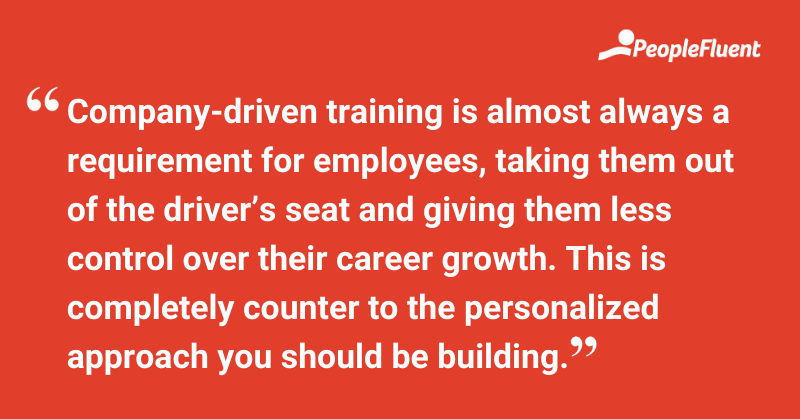Published: Nov 23, 2021Time to read: 5mins Category: Learning
3 Ways Learning Technology Can Help You Overcome Skills Gaps
Learning technology can help forward-thinking learning teams perform better. In fact, 84% of managers agree that learning can help close skills gaps on their teams. However, providing learning and development opportunities isn’t just on the shoulders of L&D departments—your HR department, your employees, and their line managers all play a part in the success of your learning programs. If you’re ready to help employees define (and take control of) their career growth, you’ll need the right learning tools to get the ball rolling.
Here, you’ll find tips on identifying and overcoming skills gaps through the use of learning tech and strategy. Many of the insights we’ll go over were taken from a recent PeopleFluent webinar with Ben Eubanks, Chief Research Officer at Lighthouse Research. We’ll also dive into the three ways you can create a learning journey that’s personalized to an individual’s goals, interests, and priorities.
1) Learning Tech Helps You Tailor the Learner Experience
If you personalize your people’s learning, you’re more likely to keep them engaged. Without a tailored experience, you could run the risk of hiring, paying, and managing a workforce that is less productive. To avoid this, you need learning solutions that help you meet the individual learning needs of each and every person in your organization.
So, how do you do this in a way that’s both relevant to the learner’s goals and rooted in data? Start by giving employees easy access to high-quality, third-party content. This allows learners to take control of when, how, and why they’re engaging with your learning programs. Plus, it helps deliver a personalized approach to learning and career growth—a very important way of engaging your learners and reaching them wherever they are on their growth path.
Consider this: only 40% of learners say that their managers tell them which skills matter. Does this mean this is only the line manager’s problem? Not at all! Employees are also responsible for finding ways to upskill or reskill themselves. But, it’s important to give them the resources and learning content to do so—something that can be achieved with an integrated learning solution that furthers talent mobility.
KEEP READING | ‘Going for Growth: How to Prepare Your Learning Teams for a Skills-Based Workforce’
2) Learner Data Allows You to Define Your Overall Learning Needs
A successful learning program requires a deep understanding of the goals you have for the learner and the business. This isn’t always easy without having the proper data or metrics. Company-driven training is almost always a requirement for employees, taking them out of the driver’s seat and giving them less control over their career growth. This is completely counter to the personalized approach you should be building.
When people have a positive learning experience, it doesn’t just lead to better performance or employee happiness, it leads to better performance for the organization as a whole. Informed by learner data, learner-driven content consumption takes the pressure off managers and L&D teams. It’s also more effective than mandatory training at getting people excited about learning and performing better. Be thoughtful when defining your learning needs and focus on creating relevant opportunities for people to use their new skills.

MORE FROM THE BLOG | ‘Are You Shifting to Self-Directed Learning? Here’s How to Do It Right’
3) Learning Tech Helps Employees Take Control of Their Career Growth
Learning leaders want to see L&D programs increase retention and engagement. These measurements are key to driving your workforce forward. When we look at high-performing organizations, it’s important to understand that employees consume content in order to improve their skillsets and enhance their careers.
On the other hand, at low-performing organizations, learners are consuming content because it’s mandatory. The measurement mainly comes from satisfaction surveys—not a great way to track whether or not your learning is valuable. Hardly a driver for better employee performance, either.
If you can prove that your learning is about increasing value (and truly prove this through your learning program), people will follow suit. Focus your learning and development efforts on helping employees take control of their careers and personal growth. It should also help you close skill gaps and allow your employees to perform at a higher level.
Keep a close eye on which employees are committed to learning or upskilling themselves—this includes existing talent as well as potential hires. This is a key indicator that a person wants to perform at a higher level than they currently do. And, it means they’re willing to go the extra mile for a company that does the same for them.

YOU MIGHT ALSO LIKE | ‘The Widening Workplace Skills Gap and How to Address It’
Give Your Employees the Tools They Need to Succeed
Ready to take your learning program to the next level and help your people do the same for their career growth? See how PeopleFluent can help you reskill, upskill, and drive better performance overall. Get in touch with sales or watch a recording of our latest webinar, ‘Reskilling and Talent Mobility: 3 Key Ideas for Greater Learning Outcomes’.